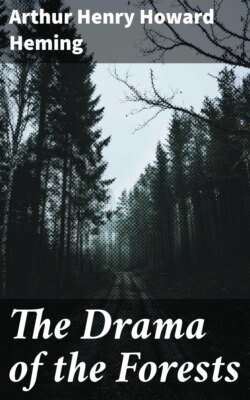Читать книгу The Drama of the Forests - Arthur Henry Howard Heming - Страница 11
На сайте Литреса книга снята с продажи.
FAMILY HUNTING GROUNDS
ОглавлениеTable of Contents
Don't let us decide just yet, however, whether the Indian derives more pleasure from life than does the white man, at[Pg 13] least, not until we return from our voyage of pleasure and investigation; but before we leave Fort Consolation it is well to know that the hunting grounds in possession of the Indian tribes that live in the Great Northern Forest have been for centuries divided and subdivided and allotted, either by bargain or by battle, to the main families of each band. In many cases the same hunting grounds have remained in the undisputed possession of the same families for generations. Family hunting grounds are usually delimited by natural boundaries, such as hills, valleys, rivers, and lakes. The allotments of land generally take the form of wedge-shaped tracts radiating from common centres. From the intersection of these converging boundary lines the common centres become the hubs of the various districts. These district centres mark convenient summer camping grounds for the reunion of families after their arduous labour during the long winter hunting season. The tribal summer camping grounds, therefore, are not only situated on the natural highways of the country—the principal rivers and lakes—but also indicate excellent fishing stations. There, too, the Indians have their burial grounds.
Often these camping grounds are the summer headquarters for from three to eight main families; and each main family may contain from five or six to fifty or sixty hunting men. Inter-marriage between families of two districts gives the man the right to hunt on the land of his wife's family as long as he "sits on the brush" with her—is wedded to her—but the children do not inherit that right; it dies with the father. An Indian usually lives upon his own land, but makes frequent excursions to the land of his wife's family.
In the past, the side boundaries of hunting grounds have been the cause of many family feuds, and the outer boundaries have furnished the occasion for many tribal wars. The past and the present headquarters camping grounds of the Strong Woods Indians—as the inhabitants of the Great[Pg 14] Northern Forest are generally called—lie about one hundred and fifty miles apart.
The natural overland highways throughout the country, especially those intersecting the watercourses and now used as the roadbeds for our great transcontinental railways, were not originally discovered by man at all. The credit is due to the big game of the wilderness; for the animals were not only the first to find them, but also the first to use them. The Indian simply followed the animals, and the trader followed the Indian, and the official "explorer" followed the trader, and the engineer followed the "explorer," and the railroad contractor followed the engineer. It was the buffalo, the deer, the bear, and the wolf who were our original transcontinental pathfinders, or rather pathmakers. Then, too, the praise bestowed upon the pioneer fur traders for the excellent judgment shown in choosing the sites upon which trading posts have been established throughout Canada, has not been deserved; the credit is really due to the Indians. The fur traders erected their posts or forts upon the tribal camping grounds simply because they found such spots to be the general meeting places of the Indians, and not only situated on the principal highways of the wilderness but accessible from all points of the surrounding country, and, moreover, the very centres of excellent fish and game regions. Thus in Canada many of the ancient tribal camping grounds are now known by the names of trading posts, of progressive frontier towns, or of important cities.
Now, as of old, the forest Indians after their winter's hunt return in the early summer to trade their catch of furs, to meet old friends, and to rest and gossip awhile before the turning leaf warns them to secure their next winter's "advances" from the trader, and once more paddle away to their distant hunting grounds.
The several zones of the Canadian wilderness are locally[Pg 15] known as the Coast Country—the shores of the Arctic Ocean and Hudson Bay; the Barren Grounds—the treeless country between Hudson Bay and the Mackenzie River; the Strong Woods Country—the whole of that enormous belt of heavy timber that spans Canada from east to west; the Border Lands—the tracts of small, scattered timber that lie between the prairies and the northern forests; the Prairie Country; the Mountains; and the Big Lakes. These names have been adopted by the fur traders from the Indians. It is in the Strong Woods Country that most of the fur-bearing animals live.
